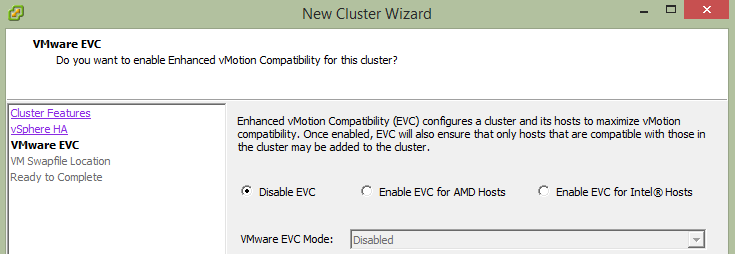VMware vSphere High Availability (HA) feature is used to prevent unplanned downtime that could cause from hardware failure, power outage, etc. VMware vSphere HA protects against host failures, guest OS failures and application failures by restarting the virtual machine in another host within the cluster. So configuring HA is one of the important tasks in vSphere infrastructure. In this post, I will show steps to configure VMware vSphere HA in vSphere 5.5
Configure VMware vSphere HA in vSphere 5.5
In vSphere HA, the hosts should be in cluster and managed by same vCenter server. Similarly, the shared storage should also be accessible by all hosts in the cluster. The hosts should also have VMkernel network with Management Network check box enabled and static IP address configured. VMware vSphere HA protects from three types of failures: -
- Host Failures: – To protect virtual machines from host failures, heart beats are exchanged between physical hosts in the vSphere cluster. If any hosts of the cluster fails then the virtual machines are restarted in another hosts in the cluster after 30 seconds by default.
- Guest OS Failures: – To protect the guest OS failures, the heartbeats are exchanged between the virtual machine and vCenter server. The VMware tools installed in the guest OS does the heartbeat exchange with vCenter server. If vCenter server stops receiving the heartbeats then the VM is restarted on the same host.
- Application Failures: – To protect applications, heartbeats are exchanged between the application itself and vCenter server. If the application stops sending heartbeats to vCenter server, then the whole virtual machine is rebooted on the same host.
Enough of the basics, now let’s start configuring vSphere HA. Here are the reminders,
- Make sure the shared storage is accessible by all the hosts that will be in same cluster.
- Create a cluster.
- Configure vSphere HA.
- Add hosts in the cluster.
Step 1. Login to vCenter server with vSphere client or web client. I will use vSphere client. Go to Hosts and Clusters view, right-click the virtual datacenter and click New Cluster.
New Cluster wizard will pop up as shown below. Type the name of the cluster, MBG-Cluster. Under the cluster feature, check Turn on vSphere HA. Click Next.
Step 2. Under Host Monitoring Status, check Enable Host Monitoring option. This option is checked by default. Similarly, under Admission Control, check Enable: Disallow VM Power on operations that violate availability constraints. The vSphere HA Admission Control policy ensures enough resources are available upon failure of any host in the cluster. Under Admission Control Policy, choose percentage of cluster resources reserved as failover spare capacity. Here, you can increase or decrease percentage value based upon your scenario. Click Next.
Step 3. Under Virtual Machine Options, you can set the restart priority of virtual machines. You can always come back later here and edit the settings. Choose Leave powered on option for Host Isolation response option.
Step 4. Under Virtual Machine Options, set VM restart priority. You can set important VMs with higher priority so that it starts earlier than other non-critical VMs. For Host isolation option, choose leave powered on option and click Next. Under VM Monitoring, choose VM and Application Monitoring from the drop down. Click Next.
Step 5. On the VMware EVC tab, you can enable if you have hosts with different processor but with same vendor and same family. If you have same processors on all hosts then leave disable and click Next.
Step 6. Under VM Swapfile location, leave the default and click Next.
Step 7. Now review the configuration settings and click Finish.
Step 8. Now simply add the hosts to the cluster object by simply adding the hosts. Right click the cluster object and click Add Host.
Step 9. New Add Host wizard will open. Here, enter the IP addresses of the host. Enter username and password of the host and click Next.
Step 10. View the summary and click Next.
Step 11. Under Assign License setting, enter the license key. Here, I will choose evaluation mode and click Next.
Step 12. Under Lockdown Mode, leave the default and click Next.
Step 13. Review the information and click Finish.
You can see the list of VMs being added in the cluster.
Step 14. Now add another host in the cluster. Repeat the same steps to add another host as shown below.
Step 15. Review the host information and click Next.
To view the cluster status, click the cluster object and select the summary tab.
To test vSphere HA, turn off the host that is running some virtual machines, after few minutes you will see the virtual machines are restarted in another (secondary) host(s) within the cluster. This is how you can configure vSphere HA.
Configure VMware vSphere HA in vSphere 5.5 is a post from: MustBeGeek


































